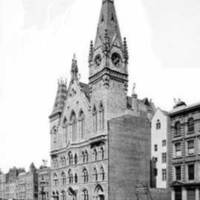Description
Congregationalism was a growing nonconformist denomination in the Victorian period, and one that increasingly liked to trace itself directly back to the Pilgrim Fathers (see, for example, the Pilgrim Father's Memorial Church built in the 1860s). In the story of those Separatists they found both romance and a justification for their views – and forthcoming friendship from New England supporters too. The Congregational Hall on Farringdon Street, London, was erected in 1875 to commemorate the ejection of Congregational ministers in 1662. It cost over £70,000, and was built in a richly ornamental gothic style. In the large public hall, which accommodated around 1200 people, there was a ‘fine painted window’ gifted by Dr Nathaniel Rogers, a Baptist and well-known donor of stained-glass windows to Anglican churches and nonconformist chapels. Made by F. Drake (Exeter), the window cost 300 guineas. It consisted of five lights – one each of St Peter and St Paul, and, in the middle, three that portrayed the embarkation of the Pilgrim Fathers at Plymouth on the Mayflower. The scene depicted a boat containing Pilgrims – men, women and children – being pushed off the shore, amid the tears of the friends left behind. In 1920, the Hall was one of the places where the 300th anniversary was celebrated; in 1968, when church attendances were dwindling and secularism growing, the church was demolished.
Source
Exeter and Plymouth Gazette Daily Telegrams (27th April 1874), 3.
For more on the Hall, see Clyde Binfield, 'Memory enstructured: the case of Memorial Hall' in Matthew Campbell, Jacqueline M.Labbe and Sally Shuttleworth (eds),
Memory and -Memorials, 1789-1914 (London, 2000).

